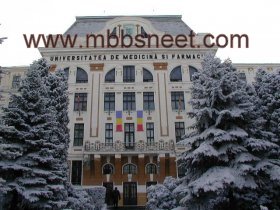Medical education in Târgu Mureș (also spelled as Tîrgu Mureș) began in 1945 as a branch of the Faculty of Medicine of the Bolyai University of Cluj Napoca. After the foundation of this university, the Faculties of Philology, Philosophy, Law, Economics and Natural Sciences started their activity in Cluj Napoca, and the Faculty of Medicine was moved to Târgu Mureș, where it operated between 1945 and 1948.
In 1948, after the Education Reform, the Medical and Pharmaceutical Institute was founded, an independent institute with the following faculties: Medicine, Paediatrics, Hygiene, Dentistry and Pharmacy. Between 1951 and 1958 it comprised three faculties: General Medicine, Paediatrics and Pharmacy. In 1958-1959 the Faculty of Paediatrics was transformed into a department; and from 1960-l961 the department of Dentistry started operating again, becoming a faculty in the academic year 1965-1966.The Faculty of Pharmacy ceased its activity between 1986 and 1990. In 1991, the Institute was given the name of University of Medicine and Pharmacy of Târgu Mureș.
After the dramatic political, economical, and social changes that took place in Romanian in 1989, the university has undergone significant changes in its image and organization.The spiritual life has become more dynamic, the logistic support a lot more substantial, and the methods have been improved and modernized. Each member of the teaching staff has benefited by participation in international conventions, trainings in new techniques, in a Western European country or the United States.
In a large degree, owed to the great raise in the number of admissions of foreign students, the Faculty of Medicine of UMF has become an international institution, with a significant increase in the number of students registering in a post-graduate program.
The University of Medicine and Pharmacy of Târgu Mureș, a famous academic institution, is accessible to all Romanian and foreign citizens without any discrimination and as a centre of excellence which provides knowledge and competence in various forms: initial and continuous training of specialists, research, expertise and consultancy in its field of competence. In the development of the university, the educational and research components have always been prevalent in training physicians, dentists, pharmacists, midwives, and nurses. The university has over 3200 national and international students as well as over 700 teachers and researchers.
The Digital Library is made up of collections created by the digitization of some documents in the Museum Hall of History of Medicine, as well as from the publications of the teaching staff of our university.The oldest book of the Library and included in this collection was published in 1532.
The University has research laboratories with advanced equipment. The Center of Advanced Medical and Pharmaceutical Research, projected on a total surface of 4.092 square meters on 5 levels, from a budget of 10.47 million EUR, represents an example of a high quality research infrastructure on international level, serving as a reference center for both basic and clinical medical research in this country. The modern facilities in this unique research complex include a DNA and plasma bank, that will collect and store biologic materials and stem cells from patients, serving as a unique source of data for future research, and several high-technology laboratories with latest generation equipments: immunology, chromatography and mass spectrometry, laser flow citometry, confocal microscopy, molecular biology, genetics, advanced cardiac imaging, metabolomics and others.
Click here for (Real Information & Real Package) about MBBS in China, MBBS in Bangladesh, MBBS/MD in Georgia, MBBS/MD in Other Countries
MBBS Exit Exam/MCI Screening Test/NEXT/FMGE, NEET.PG, USMLE, PLAB
Call/Whatsapp Mr. Arun Bapna +91 90010 99110 for personalize counseling based on Entrance Exam Score, 12th Percentage, 12th Passing Year and Budget.






